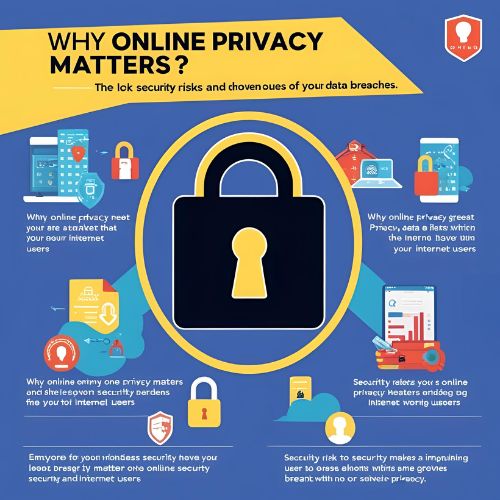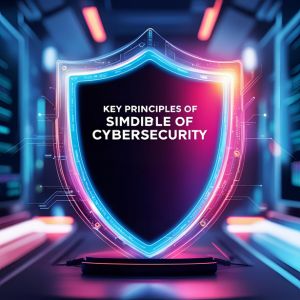In today’s digital age, our lives are increasingly intertwined with the online world. From social media and online banking to email communications and online shopping, our personal information is constantly flowing across the internet. While this connectivity offers incredible convenience, it also presents significant risks to our online privacy and security.
Understanding the fundamentals of cybersecurity is no longer a niche concern; it’s an essential skill for navigating the digital landscape safely. This guide provides a comprehensive introduction to cybersecurity basics, empowering you with the knowledge and practical steps to protect your online privacy.
Why Online Privacy Matters

Protecting your online privacy is crucial for several reasons:
- Preventing Identity Theft: Cybercriminals can steal your personal information to open fraudulent accounts, make unauthorized purchases, or even file false tax returns in your name.
- Protecting Financial Information: Your financial data, including credit card details and bank account information, is a prime target for cyberattacks.
- Safeguarding Personal Data: Your online activities, communications, and personal information are valuable and should be kept private.
- Avoiding Malware and Ransomware: Malicious software can infect your devices, steal your data, and even hold your files hostage for ransom.
- Maintaining Reputation: Your online presence can impact your personal and professional life. Protecting your privacy helps maintain a positive online reputation.
Key Principles of Cybersecurity
Building a strong defense against online threats involves understanding and implementing several key principles:
1. Strong Passwords and Password Management:
- Create Strong Passwords: Use a combination of uppercase and lowercase letters, numbers, and symbols. Avoid easily guessable passwords like birthdays or common words.
- Unique Passwords for Each Account: Never use the same password for multiple online accounts. If one account is compromised, all your accounts could be at risk.
- Use a Password Manager: Consider using a secure password manager to generate, store, and manage your complex passwords. This eliminates the need to remember numerous passwords.
2. Be Wary of Phishing and Social Engineering:
- Recognize Suspicious Emails and Messages: Be cautious of emails or messages that ask for personal information, especially those that create a sense of urgency or threaten negative consequences.
- Verify Sender Identity: Before clicking on links or providing information, double-check the sender’s email address and contact information.
- Don’t Click on Unsolicited Links: Hover over links to see the actual URL before clicking. Be especially wary of shortened links.
3. Keep Your Software Updated:
- Enable Automatic Updates: Regularly update your operating system, web browser, and all other software on your devices. Updates often include security patches that fix vulnerabilities.
- Install Updates Promptly: Don’t delay installing software updates, as they are crucial for protecting your system.

4. Use Strong Authentication Methods:
- Enable Two-Factor Authentication (2FA): Whenever possible, enable 2FA on your online accounts. This adds an extra layer of security by requiring 1 a second verification step, such as a code sent to your phone, in addition to your password.
5. Secure Your Devices and Network:
- Use a Firewall: Enable the built-in firewall on your computer and consider using a hardware firewall for your home network.
- Install and Maintain Antivirus Software: Install reputable antivirus software and keep it updated to detect and remove malware.
- Secure Your Wi-Fi Network: Use a strong, unique password for your Wi-Fi network and consider using WPA3 encryption for enhanced security. Avoid using public Wi-Fi networks for sensitive activities.
6. Be Mindful of What You Share Online:
- Think Before You Post: Be aware of the personal information you share on social media and other online platforms. Consider who can see your posts and adjust your privacy settings accordingly.
- Limit Information Sharing: Avoid sharing sensitive details like your full address, phone number, or date of birth publicly.
7. Practice Safe Browsing Habits:
- Use HTTPS: Always ensure that websites you visit use HTTPS (Hypertext Transfer Protocol Secure), indicated by a padlock icon in the address bar. This encrypts the connection between your browser and the website.
- Be Cautious on Public Wi-Fi: Avoid accessing sensitive accounts or making online transactions on public Wi-Fi networks. If you must use public Wi-Fi, consider using a Virtual Private Network (VPN).
8. Understand Data Privacy Settings:
- Review Privacy Policies: Take the time to read the privacy policies of websites and apps you use to understand how your data is collected, used, and shared.
- Adjust Privacy Settings: Configure the privacy settings on your social media accounts and other online services to control who can see your information.
9. Be Aware of Malware and Spyware:
- Avoid Suspicious Downloads: Only download software from trusted sources. Be cautious of clicking on pop-up ads or downloading files from unknown websites.
- Scan Regularly: Regularly scan your devices for malware using your antivirus software.
10. Stay Informed and Educated:
- Keep Up with Security News: Stay informed about the latest cybersecurity threats and best practices by reading reputable news sources and security blogs.
- Educate Yourself and Others: Share your knowledge about online safety with friends and family.
What to Do If You Suspect a Security Breach:

If you believe your online privacy has been compromised:
- Change Your Passwords Immediately: Change the passwords for all affected accounts and consider changing passwords for other accounts as well.
- Run a Malware Scan: Use your antivirus software to scan your devices for malware.
- Contact Relevant Institutions: If your financial accounts or other sensitive information are involved, contact the relevant banks, credit card companies, or service providers.
- Report the Incident: Consider reporting the incident to the appropriate authorities or online platforms.
Conclusion: Taking Control of Your Online Privacy
Protecting your online privacy is an ongoing process that requires vigilance and proactive measures. By understanding the fundamental principles of cybersecurity and implementing the practical tips outlined in this guide, you can significantly reduce your risk of becoming a victim of cybercrime.
In a world where our digital lives are increasingly intertwined with our physical ones, taking control of your online privacy is not just a suggestion; it’s a responsibility. By being informed, cautious, and proactive, you can navigate the digital landscape with greater confidence and security, safeguarding your personal information and enjoying the benefits of the online world without unnecessary risk. Remember, staying vigilant and continuously learning about cybersecurity is the most effective way to protect yourself in the ever-evolving digital realm.
This Article was generated by AI.


